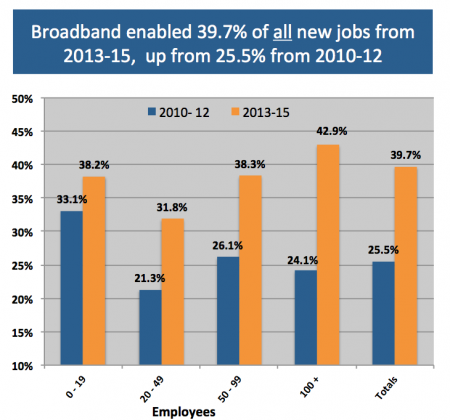Three Digital Innovations that Significantly Boost Businesses Productivity
(from SNG’s One-of-a-Kind Broadband Utilization Database)
By Thibaud Chatel
Over the last several months, a question that keeps coming up from the economic development folks we work with is this… “What are the most impactful digital innovations to improve businesses productivity?” They’re looking for ways that broadband can have the quickest impacts on the businesses in their region.
Well, based on SNG’s database (the Digital Economy Analytics Platform), which contains facts, not hearsay or hunches, here are some answers…
 Develop online service for customers and clients
Develop online service for customers and clients
The quality of a product is often not enough to convince a potential buyer. Just as important is the buying experience – the quality of service offered before, during and after the sale. It is because of this that two-thirds (67.6%) of businesses [1] provide online customer service to reduce wait times, improve records handling, improve the selling experience, and provide 24/7 availability. All those factors improve efficiency on both client and vendor sides, pushing 87.1% of businesses [2] to declare that broadband significantly improved their customer service, ranking that initiative among the top-3 broadband benefits observed by businesses and organizations.
Broadband as a learning enabler
What if the era of having to travel for tradeshows or training was over? Broadband brings the knowledge and resources needed to skills development directly inside businesses, to the computer screen. Three following facts allow us to affirm that 80.6% of businesses [3] declare broadband significantly improved their employees’ skills. Using online materials is the preferred method of learning, used by 78.4% of businesses [4], favored far more than traditional face-to-face learning. And if we consider that training existing employees is the preferred method for skills acquisition for 44.7% of businesses (whereas 33.5% prefer hiring external contractors) [5], broadband clearly appears an easy way to transfer knowledge and develop skills. .
Let’s Telework!
Teleworking is the ability to work from home or remotely. An employee has the flexibility to leave his or her desk and then pick up where he/she left off later at home. Or it’s the ability to hire the best person for the job, no matter where he/she lives. It’s also the ability for a driver or a sales representative to visualize today’s roadmap before leaving their home and to go to their destination(s) directly, skipping a stop at the office. Teleworking means productivity and service quality gain, and is applicable to every business and at every employee level. If only 49% of businesses [6] currently telework (54.2% of them [7] say broadband increased their capacity to telework, showing that more awareness is needed), the most interesting data comes from the households side, 74.6% of them [8] proclaiming that teleworking plays an important role in maintaining an healthy life-work balance. And we all know that a less stressed worker is a happy worker and a more productive one.
One last fact, 30% of businesses and organizations simply don’t know what the benefits of broadband are [9]… It is hard to believe in 2012, isn’t it? Awareness of benefits and the ROI from said benefits is critical, which is why economic development people are looking to launch targeted awareness campaigns to promote innovations in the workplace. That’s great, because we know experience and awareness matter just as much as technology and that without them, even the greatest technology remains an unused tool instead of a fully-leveraged solution.
[1] Sample of 13,810 businesses collected by SNG between 2010 and 2012.
[2] Sample of 12,581 businesses collected by SNG between 2010 and 2012.
[3] Sample of 12,131 businesses collected by SNG between 2010 and 2012.
[4] Sample of 7,940 businesses collected by SNG between 2010 and 2012.
[5] Sample of 11,310 businesses collected by SNG between 2010 and 2012.
[6] Sample of 13,514 businesses collected by SNG between 2010 and 2012.
[7] Sample of 12,130 businesses collected by SNG between 2010 and 2012.
[8] Sample of 9,444 households collected by SNG between 2010 and 2012.
[9] Sample of 11,777 businesses collected by SNG between 2010 and 2012.



